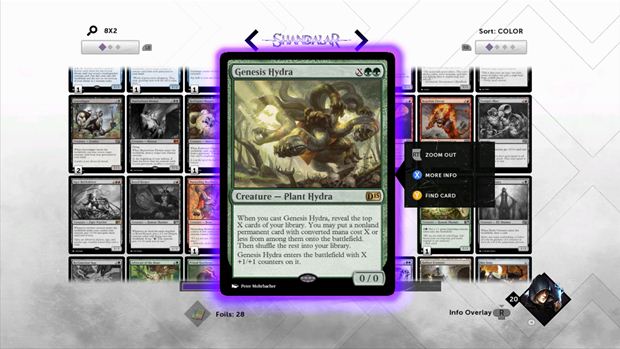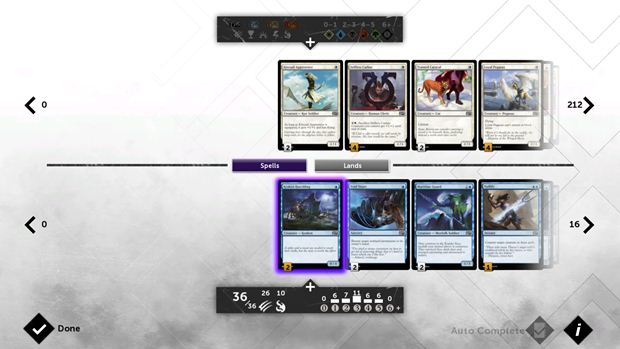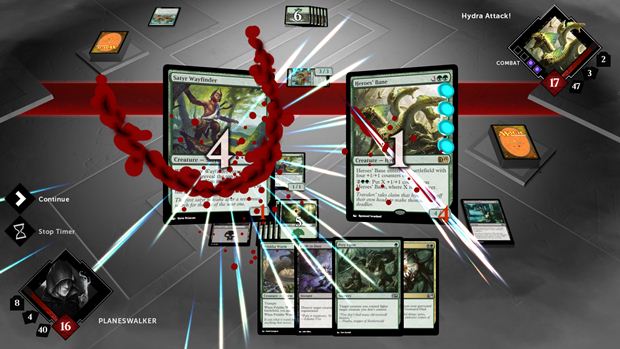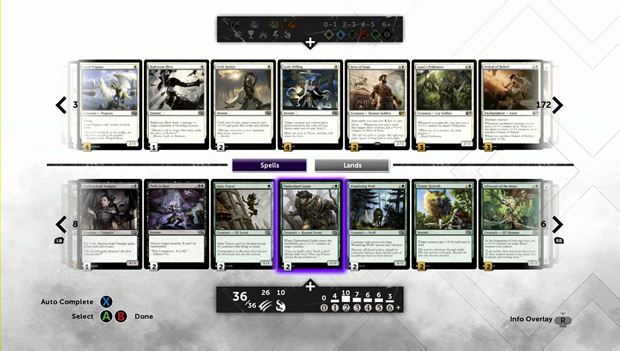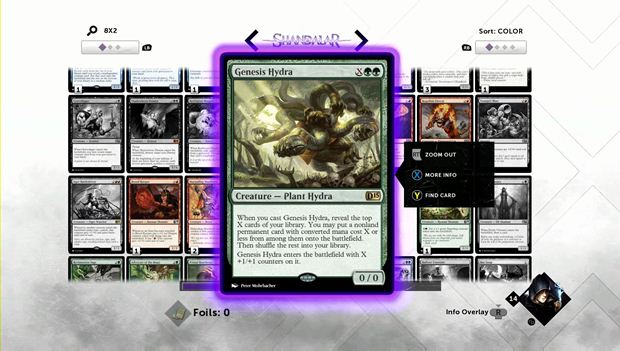
Magic 2015 is a game that demands more than it gives. It comes from a series that has a lot of history behind it and therefore has certain expectations that it’s forced to live up to. The series already has a large and dedicated group of followers, but does this mean it’s not accessible to new comers? Is it for the hardcore only? Or can anybody pick up a deck?
Duels of the Planeswalkers places a focus around card collecting and building a deck, as a means for card battling and attempting to tell a story. For the most part the game itself is quite user friendly and the main menu does well to promote this by simplifying the player’s navigation into specific tabs. Starting from single and multiplayer options for gameplay then working your way up to shop, decks, card collection, then further onto game and player profile specific settings, everything is laid in a way that allows browsing the menu feel exciting.
"For the most part the game itself is quite user-friendly and the main menu does well to promote this by simplifying the player's navigation into specific tabs."
This is backed up the game’s use of immersion through the use of an animated background and iconic pictures relating to the game and it’s characters. The tab presented for the game’s shop allows the player to purchase boosters and card collections as well as foil stickers, which holds purpose in upgrading a given amount of cards in your collection, a premium look. Similar to physical trading cards stylized in foil binding.
While this may seem quite pointless given that the cards are not physical trading cards that you can actually feel and reflect in the sun with your own fingers. It’s still a nice touch and does well to reflect on the roots of trading cards before they made their way into digital form.
Going through the card collection tab the simplification of the game’s navigation system is carried on through. And the reason why I emphasize this so much and why it’s so important is due to the fact that most people would most likely feel overwhelmed in a game which places it’s attention on card battling. Trying to keep track of what’s going on within the game, and what cards you may or may not have collected yet, can easily hit the fan if the game’s navigation system isn’t designed efficiently.
"The tab presented for the game's shop allows the player to purchase boosters and card collections, aswell as foil stickers which basically upgrade a given amount of cards in your collection a premium look. "
Magic 2015 nails it to this effect and delivers a user-friendly experience. Organized according to the games different collections, Innistrad, Theros, Ravinica, Shandalar, and Zendikar. Keeping track of your collection is a breeze. While the game’s menu system is without a doubt an immersive and friendly showpiece, it does have a few issues that forbid the game from hitting that star mark of excellence.
The first of which is the pacing between navigating menus. Switching between each tab can feel slow and clunky leaving the player unsure if they’ve actually clicked on the icon or not, or if the game has even registered the player’s input. For those with a limited amount of patience or in my case non whatsoever this can become irritating. The second issue that the game has this lies within the it’s graphical settings.
Changing from full screen to windowed mode gives rise to a scaling issue whereby the game shrinks to less than one fourth of the entire screen. It’s a no brainer that this is utterly unplayable as everything is no longer visible. And to add insult to injury, when testing the game out on a laptop the game defaulted it’s refresh rate to that of forty hertz rather than sixty, and refused to accept the screen’s native resolution without me playing around with the config files.
"Switching between each tab can feel slow and clunky leaving the player unsure if they've clicked on the icon or not, or if the game has even registered the input. "
None of these issues are game breaking so long as you play in the full screen option and tamper around with settings outside of the actual game. The problem is that none of these issues seem to make sense in a game that doesn’t necessarily emphasize ground breaking visuals, or offer up any advanced graphical settings.
The final problem with Magic 2015 is one that’s expected and at this point in time has become unwanted norm. Pay-to-play. Littered through out every menu that’s even remotely related to the actual cards of the game is the option to purchase additions to your deck.
While some may argue this works well in a game that revolves around deck building, it’s the way that it’s implemented in to the game that presents the problem. And seeing how the game isn’t free to purchase anyway, the amount of things within the game that insist the player must pay for, can justify the negativity that some players will feel towards it.
It makes the feeling of progression and skill feel useless should you choose to go in to the multiplayer portion of the game, when going up against an opponent who has emptied their wallet in to the game. Why should I progress through the game if it proves ultimately useless against those who have paid for their power? Purse pinching vs Player progression is a path to failure.
"Littered through out every menu that's even remotely related to the actual cards of the game is the option to purchase additions to your deck. "
On to more positive aspects of the game. Browsing through the game’s intuitive although be it slow interface, hiding at the back of the main menu is a tab named the Multiverse.
Here players can gain background knowledge on the more prominent characters in the game, as well as the different lands that these characters roam. It’s a nice touch to the game as it provides players with a slight sense of immersion as well as raising general interest about the game’s lore.
Moving on to the actual bulk of the game players are offered to skip the game’s tutorial and dive straight in. It’s clear that newcomers would be foolish to do so as this can damage the player’s enjoyment when progressing on to more difficult stages within the game. Providing a small taste of background knowledge to the Magic universe, the game’s narrator briefs you in on how to play the game while speaking of it’s lore. It’s here the player learns that they are part of a group of sorcerers named planeswalkers, who can travel between different planes of existence. The story falls short of anything that’s even within the realm of good storytelling, but as it provides a reasoning for gameplay, it’s not something that should be taken seriously anyway.
Divided into cards of different nature, each depicted by the type of deck they originate from, their are many different type of cards all varying in use case. These types of cards are represented through five colours. The tutorial does well in teaching the player about these cards by dividing itself into stages, all accessible by completing the stage beforehand. Casting spells, summoning creatures, and general interaction within the game requires the use of resources in a form known as mana.
"Moving on to the actual bulk of the game players are offered to skip the game's tutorial and dive straight in. It's clear that newcomers would be foolish to do so as this can damage the player's enjoyment when progressing on to more difficult stages within the game. "
Mana is acquired by playing land cards from your hand, and different spells will require a certain amount of mana before it can be played. As you would know doubt have guessed lands are crucial to the players chance in battle, as there’s a certain amount of balance, patience, and thought that must be applied when going up against your opponent.
Different creatures carry their own traits of attack damage and life points. Both of which are displayed on their cards with the player being free to zoom in to their opponents card so the know what they’re up against.
There’s also card specific rules for each creature that must be followed, along with life points solely to the player, that must be protected by blocking with his or her own cards. This is something you’re most likely to come across early in the game, regardless if you follow the tutorial or not. This adds a level of depth and strategy to the game without it becoming to complex while remaining deep enough not to be taken lightly.
Green deck for example emphasizes large powerful creatures that attack head on, by the use of resources, targeting the player unless he is or she has the means to retaliate with their own cards. Black decks on the other hand specialize in removing your opponents creatures from the battle using cards such as the Assassinate type. The black deck type also makes use of card types that can deal one hit kills as well as bringing back cards from the dead, regardless if they belong to you or your opponent.
One thing that’s noticeable in a visual sense through the artistic design of the cards, as well as how the gameplay differs according to the type of deck, is the how well the game keeps inline with it’s own theme. Green decks carry a sense of fantasy creatures based highly on beasts and animals such as centaurs, elves, birds, and plant like creatures.
While black decks stray towards something more evil along the lines of vampires, zombies, demons, and black cats. The mana cards compliment this by the design of their lands such as forests for green decks and swamps for black. It’s a small touch that goes along way, and it does well in keeping the player invested in it’s world.
There’s also other deck types within the game such as red and white, which are just as distinctive from each other as green is to black and white is to green and so on, all containing their own deck and card specific properties. While I wouldn’t necessarily cast the deck types as classes they do present something of a similar nature, and it’s something that the player will also discover in the game as they adapt their skills and card collection according to their preference.
" While black decks stray towards something more evil along the lines of vampires, zombies, demons, and black cats. The mana cards compliment this by the design of their lands such as forests for green decks and swamps for black. "
Starting the game with a mixed variety of cards split between two per-determined colour types, the game itself bares much similarity to the matches played through in the tutorial. The distinction however lies obviously in the pace at which the game plays out, the lack of a guide, the game’s plot motive for each battle, and how different opponents within the game differ from one and other in terms of their own strategy and motives within the story.
Chaos and slaughter, cruel denial, and life and death are three of the available deck types to choose from and as their name implies, they each possess different traits from the five groups of colour . The only killjoy about this feature is that the player isn’t allowed to select any cards that will go in to that deck type as the beginning of each match is based on shuffling your deck as a means of playing with what’s already available.
This only changes as the game progresses forward and you gain more freedom of choice for what cards you want. Magic 2015 is a game with a lot on the table, and while some features work better than others, and the annoyance of the pay-to-play system is mandatory, it’s easy to see where the game can and should have been adjusted in some ways to better suit the player’s amount of choice within the game. There’s no denying the enjoyment that can be received from the game, it’s just a shame it’s let down by small nuisances that shouldn’t have been there in the first place.
This game was reviewed on the PC.
Complex and enjoyable battles and an immersive artistic design.
Pay-to-play runs rampant and counter-attacks the reasoning for progression.









